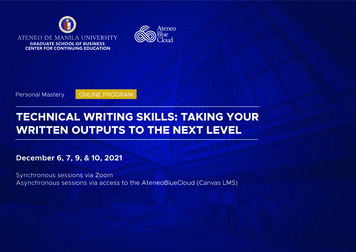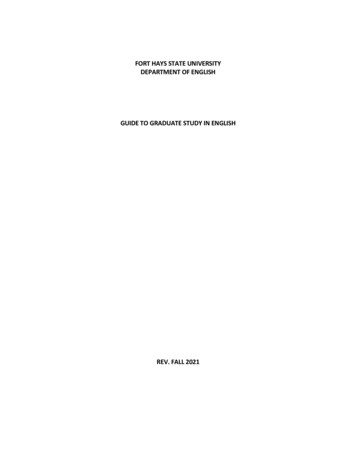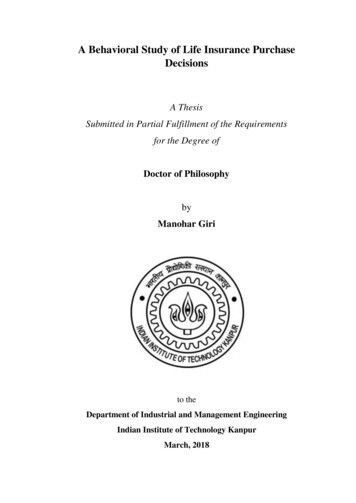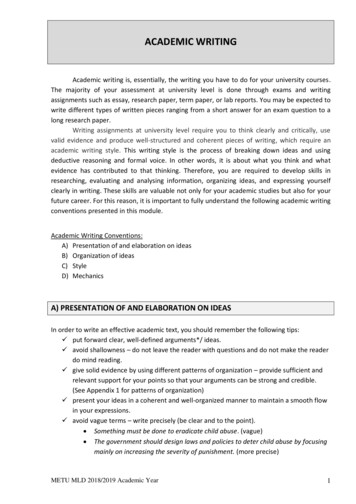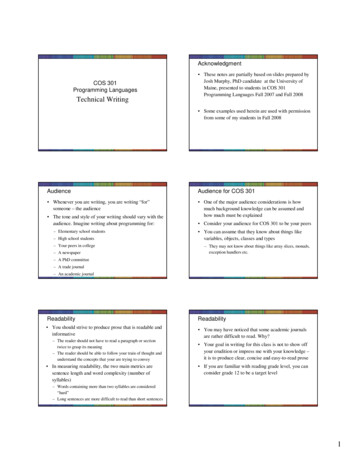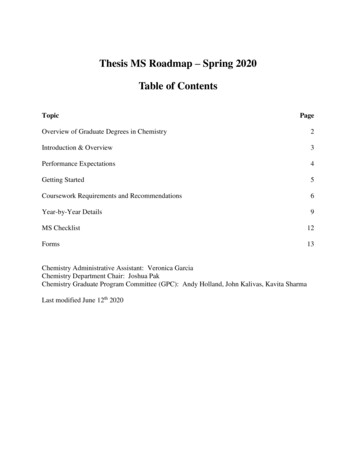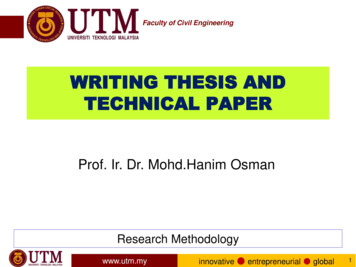
Transcription
Faculty of Civil EngineeringWRITING THESIS ANDTECHNICAL PAPERProf. Ir. Dr. Mohd.Hanim OsmanResearch Methodologywww.utm.myinnovative entrepreneurial global1
Presentation Outline Presentation &publication ofresearch finding Writing a researchpaper Writing dissertation Writing skill Writing Technicalpaper Writingwww.utm.myTest Reportinnovative entrepreneurial global2
Why You Must Publish? To benchmark our research findingsTo get response from othersTo disseminate new findings / knowledgeTo get good reputationTo get better promotionTo pass Ph.D./D.Eng./D.Sc. programTo satisfy academic interestTo develop intellectual traditionwww.utm.myinnovative entrepreneurial global3
phD students Conversion of thesis to papers The future funding of researchwww.utm.myinnovative entrepreneurial global4
Which Publication? Unpublished research reportSpecialized magazineDissertation / ThesisMonographSeminar proceedingRefereed journalBookwww.utm.myinnovative entrepreneurial global5
Writing a Research Paper Basic considerationsFinding a good topicFinding suitable literature materialsEvaluating literaturePresenting research methodologyCompiling experimental dataAnalysis & discussionFormatting & illustrationsA sample of research paperwww.utm.myinnovative entrepreneurial global6
Criteria of a Good Research Paper Published in a flagship refereed journalSubject on frontier of knowledgeResearch findings are originalSignificant area of studyPublished at the right timingMinimum mistakesMethodologically soundAnalytically soundGrammatically soundClear diagramReferences are up-to-date & significantCorrectly formattedwww.utm.myinnovative entrepreneurial global7
Finding a Good Topic Steps to a good topic: Choosing a topic that interests you Doing preliminary research Narrowing your topic Deciding which type of research paperwww.utm.myinnovative entrepreneurial global8
Step Choosing a topic that interestsyou“Membranebioreactor forwastewater treatment”www.utm.myinnovative entrepreneurial global9
Step Narrowing your topic“Molecular detection of microbialcommunity using PCR, DGGE andFISH in sludge from membranebioreactor”www.utm.myinnovative entrepreneurial global10
Presenting Research Methodology Precise.Normally not more than1 page.Refer to other articles or books for details.E.g. “Water quality analysis in this study is basedon the Standard Methods (1999). Describe: How to do it (method) Equipment & materials Process & flow chart Durationwww.utm.myinnovative entrepreneurial global11
Compiling Experimental DataData can be presented in various forms: GraphTablePhotoetc.www.utm.myinnovative entrepreneurial global12
Analysis & Discussion Should be 50% of the paper Relate to the theoretical part Supported by graphs, tables, photo etc. Formula can be written But no calculation be shown Analysis on experimental data: Compare with theory Compare with numerical results Compare with other works State the importance of the findingswww.utm.myinnovative entrepreneurial global13
Formatting & Illustrations Follow the guideline prepared by thepublisher Principles: To help to clarify your written explanation Simple presentation Easy to understand Related to the theoretical derivation 10 (graph table etc.)www.utm.myinnovative entrepreneurial global14
SAMPLEExcellent researchpaperwww.utm.myinnovative entrepreneurial global15
Writing A Dissertation Level of dissertationsDissertation vs Research paperFormattingExamples of a good and a baddissertationwww.utm.myinnovative entrepreneurial global16
Level of Dissertations Undergraduate dissertation Masters dissertation Doctoral dissertationImportantMessagewww.utm.myinnovative entrepreneurial global17
Undergraduate Dissertation Training basis No significant academic contribution Evaluation on: Writing skill Presentation Sequence and formatting Data analysiswww.utm.myinnovative entrepreneurial global18
Dissertation vs Research PaperItemsDissertationResearch Paper 200 ppWhole research1 Ph.D. 1 M.Sc. 1 B.Sc. WriterAmateurWritingRelatively easyPresentation Full research dataFormatUniversity-basedPublication UnpublishedSizeScopewww.utm.my 8 ppPortion of research4 research papers2 research papers1 research paperProfessionalDifficultSimplified & selectedJournal-basedPublishedinnovative entrepreneurial global19
Formatting & Illustration Follow the university’s guidelineSequence of chaptersFont, size, spacing, etc.Figure headTable headReferencesAppendixwww.utm.myinnovative entrepreneurial global20
Sequence of ChaptersModel A Model BIntroductionLiterature reviewAim & objectivesMethodologyResultsAnalysis & DiscussionConclusion &Recommendationwww.utm.myIntroductionAim & ObjectivesLiterature reviewMethods & MaterialsResults & DiscussionConclusioninnovative entrepreneurial global21
References Ujang Z. (1999) Molecular detection ofmicrobial community in sludge of membranebioreactor. Wat.Sci.Tech. 78 (5) 230-238. Buckley C.A. (1999) Membrane Processes.John Wiley, London, pp. 23-25. Ujang Z. & Buckley C.A. (1999) Sludge agemodeling in MBR. Proc. Int. Conf. MembraneTech. For Environ. Mgmt., Tokyo Univ. &IAWQ, Tokyo, Nov 1-4, pp. 23-30.www.utm.myinnovative entrepreneurial global22
Thank youwww.utm.myinnovative entrepreneurial global23
THES criteria Peer reviewStaff-student ratioCitationEmployers reviewInternational facultyInternational studentswww.utm.myinnovative entrepreneurial global24
Thesis and journal paper Similarities Differenceswww.utm.myinnovative entrepreneurial global25
What do we look for in thesis Is there clear understanding of the problem? Are the objective clear? Has the student carried out paper literature survey? Is it ascholarly effort? Are the experiment carried out systematically ? Design ofexperiment, range, etc. Are the results presented methodically? Are the results analysed with scientific rigour? Does the student understand the applicability of the results ? Is there an attempt to generalise the results ? Does the student show analytical and/or numerical ability ? Do the conclusions relate to the results presented and addressthe objectives set out in the introduction? And the importantly the presentation (this is the only record ofthe studies) : structure, language, figures, tables, references.www.utm.myinnovative entrepreneurial global26
Why PhD ? To get training on various aspect of research To become a critical thinker To develop into an independent researchworker To extend the frontier of research subject To become a research engineer To become a better teacherwww.utm.myinnovative entrepreneurial global27
Technical paper The must be originality in the paper. This is thefundamental criterion The objective should be clearly defined and the completedstudies should be reported in full A technical paper normally makes 2 or 3 important points(these points should appear three times in the paper) Should be clear, concise, logical, precise, accurate andreadable Throw away superfluous material and areas of ambiguity.Should be ruthless in choosing only relevant material froma vast body of data. Paper as a detective story Paper is not a piece of literature but a readable prose Follow the guideline of the journalwww.utm.myinnovative entrepreneurial global28
Writing thesis and technical paper A well written thesis under an exactingsupervisor and the first paper published fromit are the starter First paper published in a reputed journal is amajor step, giving all the importanceconfidencewww.utm.myinnovative entrepreneurial global29
Choice of journal To inform others of the work you havecarried in the best way possible The paper may be : Theoretical and experimental both An application to design practice Case studies of an interesting project in whichsomething is different from the establishedpracticewww.utm.myinnovative entrepreneurial global30
Typical contents of technical paper The paper should capture non-experts andimpress experts Typically the paper contains the following Title : what is the paper about ? Summary : the condense version of thewhole paper Introduction : what is your objective ? Numerical simulation/theory : what didyou do with mathematics ? Experimental details : what did you doby experimentation ?www.utm.myinnovative entrepreneurial global31
Typical contents of technical paper Experimental results etc are included toprovide necessary facts and evidencesto fulfil the objectives. They are used tobring out new ideas from deduction orinduction Results : what did you find? Discussion : what do the results mean? Conclusion : What the ending ? References acknowledgmentwww.utm.myinnovative entrepreneurial global32
Paragraphs Do not jumble up too many ideas, especiallyunrelated, in one paragraph. One idea perparagraph, Write simple sentences readable in logicalsequence, Get the paragraphs in right order, Avoid repetition Check the logic, continuity, etc. Check for inclusion of all relevant points Keep an eye on the paragraph length The structure in the finished product can bedifferent from the initial outlinewww.utm.myinnovative entrepreneurial global33
(i) Summary Perhaps the last section to write. Thereader wants a quick outline of the paper. The summary must be self-supporting. Itshould not contain references and shouldinclude : What is the paper about ? How did you do the research ? What is the scope of the research ? What are the main findings ? What are the important conclusions ? Are there any applications ?www.utm.myinnovative entrepreneurial global34
(ii) Introduction Introduce the topic Brief description of related studies State clearly the problem that has beenstudied and how it is related to previousstudies Describe briefly the method of study and thescope of your work You should be able to capture the nonexperts among the readers with theintroduction)www.utm.myinnovative entrepreneurial global35
(iii)Details of experimental investigation A neat diagram. Refer it in the text as theapparatus is described Salient features of the experimentalapparatus (for details reference may begiven to the thesis or to previouslypublished work) Highly novelty of experimentation Experimental conditions including range ofvarious parameters The instruments used, their limitations andtheir accuracywww.utm.myinnovative entrepreneurial global36
(iv) Theoretical analysis Perhaps slightly easier to write Keep the reader informed, briefly, what the theory is about Write the important assumptions first followed by those thesecond order importance Number the equationns Do not include every step of manipulationof equations Write the important results derived from the theory Followconvention in graphical presentation of theoreticalresults If the theory predicts well, do not be overjoyed When comparing with experimental results, express thelimitations of theory and experimentswww.utm.myinnovative entrepreneurial global37
(v) Results The hardest part to write you must clear of whatpoints you want to convey the reader Interpretation of results Logical steps Establish your new ideas Concentrate on key facts and figures Ensure to include all important facts Include relevant figures Refer to all figures and tableswww.utm.myinnovative entrepreneurial global38
Results Describe and discuss critically the significance of thefigures Assess the validity of the results Make comparisons with other investigations and withtheory Analyse discrepancies of the results obtained Critically review what has been achieved Be careful of generalisations Write sound conclusions from deduction or inductionor bothwww.utm.myinnovative entrepreneurial global39
(vi) Graph Graphs and tables should complement your writingmaking the text clear Is it numbered ? Does it have a title ? Is it referred to in the text? Is it explained / discussed in the text ? Is it clear ? Are the variables on the correct axes ? Are the variables labelled with names and units? Are the different data points on the graph distinguishable? Are the legends inside the figure clear ? Are the curves drawn sensible ?www.utm.myinnovative entrepreneurial global40
(vii) Table Is it numbered ?Does it have a title ?Is it referred to in the text?Is it explained / discussed in the text ?Is it clear ?Doest it have unambiguousheading/units?www.utm.myinnovative entrepreneurial global41
(viii) Conclusions Should be based on your researchPoint form is preferableNo speculation is allowedDo not write as conclusion if it has notbeen discussed in the thesis Conclusions should be in present tensewww.utm.myinnovative entrepreneurial global42
Reference Author’s nameTitle of the paperPublishing journalVolume numberPartYearpageswww.utm.myinnovative entrepreneurial global43
Thesiswww.utm.myinnovative entrepreneurial global44
What do we look for in thesis Is there clear understanding of the problem? Are the objective clear? Has the student carried out paper literature survey? Is it ascholarly effort? Are the experiment carried out systematically ? Design ofexperiment, range, etc. Are the results presented methodically? Are the results analysed with scientific rigour? Does the student understand the applicability of the results ? Is there an attempt to generalise the results ? Does the student show analytical and/or numerical ability ? Do the conclusions relate to the results presented and addressthe objectives set out in the introduction? And the importantly the presentation (this is the only record ofthe studies) : structure, language, figures, tables, references.www.utm.myinnovative entrepreneurial global45
Project Report / Dissertation /Thesis Title PageStudent’s DeclarationDedication and Acknowledgement (optional)Abstract (in Malay and English)Table of ContentsList of TablesList of Figures and PlatesList of Symbols and AbbreviationsList of AppendicesChapters (main texts)References and Bibliography (optional)Appendiceswww.utm.myinnovative entrepreneurial global46
Abstract Background (including the purpose ofthe study) Methods Results Conclusionwww.utm.myinnovative entrepreneurial global47
Chapter for Introduction Introduction and background of the studyProblem StatementHypotheses or research questions (optional)Aim and objectivesScope and limitationImportance of the studyGeneral outline of research methodology(optional) Outline of the report (optional)www.utm.myinnovative entrepreneurial global48
Introduction the background to the work (in relation to significantissues, problems, ideas) the objectives of the research key definitions and concepts to be used optionally, an overview of the report (mapping out itscontents)www.utm.myinnovative entrepreneurial global49
Problem Statement The formulation of a researchencompasses the background of theissue or problem relevant to the topic. Itshould describe the development of theproblem and provide the focus of theresearch.www.utm.myinnovative entrepreneurial global50
Aim and Objective The aim is a general statement to explain theoverall goal of the project. It can be in ameasurable or non–measurable form. Objectives are specific goals that are arrivedin undertaking the project to achieve the aim. Each of the objectives should be quantifiableor measurable. The way in which a project iscarried out is usually guided by the specificobjective(s) of the study.www.utm.myinnovative entrepreneurial global51
THESIS––––––––––Thesis format and StructureHow to start writing a thesisPlanning and timeline for writing a thesisRole of student and supervisor in thesispreparationSubmission regulationAssessment of thesisViva-voce Preparation of thesisEthics and codes of ve entrepreneurial global52
Project Report / Dissertation /Thesis Title PageStudent’s DeclarationDedication and Acknowledgement (optional)Abstract (in Malay and English)Table of ContentsList of TablesList of Figures and PlatesList of Symbols and AbbreviationsList of AppendicesChapters (main texts)References and Bibliography (optional)Appendiceswww.utm.myinnovative entrepreneurial global53
Chapter for Literature Review A review of the material that already exists on thetopic in question. The current research should buildon existing knowledge, not “re-invent the wheel”. The literature review should demonstrate how theresearch being reported relates to previous researchand, if possible, how it gives rise to particular issues,problems and idea that the current researchaddresses. Some project reports have more than one chapterdedicated to literature review. However the exactnumber of chapters required should be agreed uponby the project supervisor. Wherever necessary, eachchapter should have its own title which reflects thecontents of the chapter.www.utm.myinnovative entrepreneurial global54
Chapters for ResearchMethodologyThese chapters describe in detail the methodologyadopted. Depending on the nature and scope of theproject, it describe: Type of data used Instrumentation / equipment / apparatus Method of sampling / model set up Description of sample / model / population Technique of laboratory experimental work Technique of data collection, processing, andanalysis Questionnaire design etc.www.utm.myinnovative entrepreneurial global55
Chapters for Data Collection,Results (and Analysis) Detail description on collection and analysis of the data(using appropriate statistical tool, if applicable). The sources of the data must be clearly specified(eg.traceability to the specimen’s identification) Large data sets and raw data are commonly placed inthe appendices while a typical set may be presented inthis chapter. The results of the analysis are normally presented ingraphical or tabular format. Relevant findings and observation before going aheadwith the analysis and implications toward the issues,problems or ideas that prompted the research. In other words,let’s see whatwe havefound. globalwww.utm.myinnovative entrepreneurial56
Chapter for Discussion of Results(Analysis and Discussion) Use the result of the analysis to make inferences inorder to support the arguments. The discussion must be confined within the scopeand objectives of the project. A critical appraisal of the results is required to assesshow each of the objectives has been achieved, andhow the questions have been answered. Comparison with other studies All arguments must be supported by evidences fromvarious data from the study.www.utm.myinnovative entrepreneurial global57
Chapter for Conclusions andRecommendations Must be clearly stated with reference to theobjectives and questions in the introduction. Reflect exceptional understanding and insight. To summarise the conclusion of each previouschapters in new final concluding remarks. Problem encountered during the course of theresearch Suggestion for improvement and new directions forfurther research An evaluation of the research and its contribution,and concluding remarkswww.utm.myinnovative entrepreneurial global58
Abstract Background and e entrepreneurial global59
AppendicesThe place for materials which are toobulky for the main body of the text. Extensive tables of data Questionnaires used in the survey Extracts from interview transcript Technical and standard specificationwww.utm.myinnovative entrepreneurial global60
References and Bibliography References – provide direct reference to originalsources whenever possible Bibliography – provide other sources consulted, mustbe given for a good report.www.utm.myinnovative entrepreneurial global61
Organizing your chapters usingpocket fileBased on research methodology:Chapter 1 ?ChapterChapter 1Chapter22 ? Chapter 3Chapter 3 ?Chapter 4 ?Chapter 5 ?ChapterChapter 4Chapter65 ? Chapter 6www.utm.myinnovative entrepreneurial global62
Time tableMonths061218243036EarlySubmissionProposalWhen doyou plan tograduate ?www.utm.myProgressOralexamination(Viva voce)Start writinginnovative entrepreneurial global63
The tenses in scientific reportingSection / Context in a reportAppropriate tenseAbstractPast tenseIntroductionMostly present tenseMethodologyPast tenseMethods, materials usedPast tenseResultsPast tenseDiscussionMix of past and present tense,some times future tenseDescription of tables and figuresPresent tenseAttributionPast tensewww.utm.myinnovative entrepreneurial global64
Terima kasihwww.utm.myinnovative entrepreneurial global65
RESEARCH METHODOLOGY AND DESIGN Relationship between methodology & designPurpose of research designDeveloping Conceptual and operational frameworkTypes of research design (Theory building/testing/extension; Inductive/deductive)Steps in Research DesignVariables measurementsSelecting and developing research instrumentsQuantitative vs. qualitative research design and methodEvaluation of Research Methodology and designGantt Chart and milestonewww.utm.myinnovative entrepreneurial global66
DATA COLLECTION What is data collection?Types of data:primary vs secondaryqualitative and quantitativeSelecting your data: sampling techniques and designMethods, tools and techniques for data collectionwww.utm.myinnovative entrepreneurial global67
DATA ANALYSIS Types of Data AnalysisSteps in Data AnalysisConnecting research objective to data analysisMathematical/statisticalData verification and validityParametric/non-parametric analysisSurvey to experimentation and data analysisQuantitative analysisQualitative analysiswww.utm.myinnovative entrepreneurial global68
Project Report / Dissertation / Thesis Title PageStudent’s DeclarationDedication and Acknowledgement (optional)Abstract (in Malay and English)Table of ContentsList of TablesList of Figures and PlatesList of Symbols and AbbreviationsList of AppendicesChapters (main texts)References and Bibliography (optional)Appendiceswww.utm.myinnovative entrepreneurial global69
Chapters writing vs Actual WorkChapters WritingActual work sequenceAbstractTable of contentsChapter 1 – IntroductionChapter 2 – LiteratureReviewChapter 3,4 – Methodologychapters ( result)Chapter 5 – Results /Analysis / DiscussionChapter 6 – Conclusion Literature Review Problem statement &Objective Methodology (execution) Results / Analysis /Discussion Conclusion Introduction Table of contents Abstractwww.utm.myinnovative entrepreneurial global70
Chapters Chapter 1 – Introduction Chapter 2 – Literature Review Chapter 3,4 – Methodology chapters( result) Chapter 5 – Results / Analysis /Discussion Chapter 6 – Conclusionwww.utm.myinnovative entrepreneurial global71
1.1 Introduction and background It’s not a literature review! It should be a summary ofexisting evidence that motivates your specific,proposed work. Start broad (e.g. construction delay, need forguideline, etc.), become increasingly specific End with a review, and broaden out to discusspotential applications (importance) of the proposedwork Topics to be addressed: what’s been done; whathasn’t; what is needed and why; indicate your part orcontribution (scoping your domain) Intro should contain some statements of objectives,purposes, and hypothesis.www.utm.myinnovative entrepreneurial global72
Placement is flexible, though, and these could be inseparate sections between Intro and Methods, or evenpart of the Methods. Depending on the specifics, not allof these (objective, purposes, and hypotheses) willalways been relevant. More important that it be clearand readable. How long should it be? Long enough to satisfy theabove goals. Typically 10-30 pages for an MS, longerfor a PhD proposal. When summarizing existing literature, it is not enoughjust to describe what authors X, Y, and Z did. Resultsshould be interpreted, in the context of the overall reviewand study objectives. In particular, discuss contrasting evidence, possiblesources for discrepancies (experimental design, lack ofcontrols, sensitivity of measures, etc.), and theimportance of resolving the differences.www.utm.myinnovative entrepreneurial global73
1.2 Problem Statement /Questions to beanswered The formulation of a researchencompasses the background of theissue or problem relevant to the topic. Itshould describe the development of theproblem and provide the focus of theresearch. Question to be answered is more focustowards the measurable subject matterto be solved at the end of the research,which is needed in order to achieve theobjective.www.utm.myinnovative entrepreneurial global74
1.3 Aim and Objectives The aim is a general statement to explain theoverall goal of the project. It can be in ameasurable or non–measurable form. Objectives are specific goals that are arrived inundertaking the project to achieve the aim. Each of the objectives should be quantifiable ormeasurable. The way in which a project iscarried out is usually guided by the specificobjective(s) of the study. specific and clearly filling some hole/needaddressed in the Introduction.www.utm.myinnovative entrepreneurial global75
2.0 Literature Review A review of the material that already exists on thetopic in question. The current research should buildon existing knowledge, not “re-invent the wheel”. The literature review should demonstrate how theresearch being reported relates to previous researchand, if possible, how it gives rise to particular issues,problems and idea that the current researchaddresses. Some project reports have more than one chapterdedicated to literature review. Wherever necessary,each chapter should have its own title which reflectsthe contents of the chapter.www.utm.myinnovative entrepreneurial global76
Research Methodology (Chapter 3,4,.)These chapters describe in detail the methodologyadopted. Depending on the nature and scope of theproject, it describe: Type of data used Instrumentation / equipment / apparatus Method of sampling / model set up Description of sample / model / population Technique of laboratory experimental work Technique of data collection, processing, andanalysis Questionnaire design etc.www.utm.myinnovative entrepreneurial global77
Research Methodology (Chapter 3,4,.)a) What will be done, how, and why? Inparticularly “why” (why this IV, why theselevels, why this measure, )b) With respect to how and why, there istypically more than one way to dosomething, and you must explain (andsometimes justify) your choice.c) The methods should have clearconnections to the hypotheses.d) In general, proceed from broad tospecific, butalsoensurethatacontextiswww.utm.myinnovative entrepreneurial global78
d) For example, don’t describe specifictest method before you’ve evenexplained the overall approach and thedifferent independent and dependentvariables.e) For widely-used and generallyaccepted approaches, just summarizewith reference to the literature. Forother approaches, more explanationand justification needed.www.utm.myf) The readershould beinnovativeable toentrepreneurial global79
a) Subsections are often used such as:Overview; Participants; Procedures;Instrumentation; Experimental Design;Data Reduction; Analysis (stats)b) Somewhere (typically in ExperimentalDesign), there should be an explicitstatement of the independent anddependent variables (or factors, ormeasures)www.utm.myinnovative entrepreneurial global80
Some general tips Each paragraph proceeds from general to specific. Some have suggested that reading the first sentence ofevery paragraph in the document should convey theessential meaning of the whole. Vary the structure of your sentences and paragraphs. Use transitions between paragraphs (either the lastsentence of the proceeding one or the first sentence ofthe subsequent one, should tie the two together). Avoid one-sentence paragraphs (generally at least 3sentences comprise a paragraph) Consider optional presentation methods. Often thesame thing can be conveyed by text, graphs, tables,diagrams, etc. Pick what is the most effective, but avoidduplication.www.utm.myinnovative entrepreneurial global81
Some common mistakes to avoid: Repetitive sentence structure (The The The or However, Additionally, Therefore, ) Avoid complex words, where simpler oneswill convey the information (like utilize vs.use; cognizant vs. aware; though personalstyle always has a role). There is no advantage to be gained bymaking something obscure. The scientificvalue is not enhanced by complicatedwww.utm.myinnovative entrepreneurial global82
Data Collection, Results (andAnalysis) (Chapter 5,.) Detail description on collection and analysis of the data(using appropriate statistical tool, if applicable). The sources of the data must be clearly specified(eg.traceability to the specimen’s identification) Large data sets and raw data are commonly placed in theappendices while a typical set may be presented in thischapter. The results of the analysis are normally presented ingraphical or tabular format. Relevant findings and observation before going ahead withthe analysis and implications toward the issues, problems orideas that prompted the research. In other words, let’s see what we have found.www.utm.myinnovative entrepreneurial gl
Technical paper The must be originality in the paper. This is the fundamental criterion The objective should be clearly defined and the completed studies should be reported in full A technical paper normally makes 2 or 3 important points (these points should appear three times in the paper)

